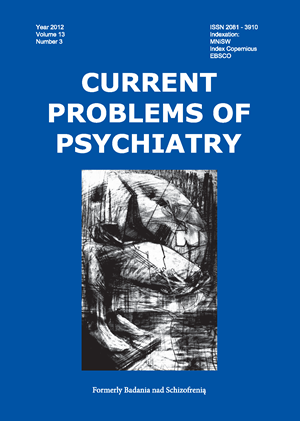Reakcje idiosynkrazji na leki psychotropowe
Keywords:
DRESS syndrome, neuroleptic malignant syndrome, idiosyncrasyAbstract
The content of our dissertation relates to idiosyncratic reactions connected with the use of antipsychotic drugs. The below review of articles concerning reaction of idiosyncrasy in the course of treatment with psychotropic drugs brings closer the scale of therapeutic problems during the psycho pharmacotherapy. Idiosyncrasy is an expression used to describe unexpected side effects independent from the drug doses. There are many syndromes of the idiosyncrasy occurring after the drug use. They are described with the following terms: Dress Syndrome (being the syndrome of reaction after drug usage with eosinophilia and systemic symptoms), HHS (Hypersensitivity Syndrome), DIHS (Drug Induced Hypersensitivity Syndrome), DIDMOHS (Drug Induced Multiorgan Hypersensitivity Syndrome) and Drug Induced Pseudolymphoma. The clinical extreme of idiosyncratic reaction is neuroleptic malignant syndrome.
References
1. Deng X., Luyendyk J.P., Ganey P.E., Roth R.A. Inflammatory Stress and Idiosincratic Hepatotoxicity. Hints from Animal Models. Pharmacol. Rev. 2009. Vol 61; No:3: 262-282.
2. The Merck Manual for Health Care Professionals. Adverse drug reaction. Last full review/revision August 2007 by Joan Tarloff.
3. Dra. Liliana Cuellar, Dr Ariel Sehtman, Dra Juliana M del Sel, Prof. dr. Miguel Allevato, Prof. dr. Hugo Cabrera. Sindrome DRESS desencadenado por psicofarmacos. Act. Terap. Dermatol. 2007; 30: 304-309.
4. Haralampos J. Milionis, Antigone Skopelitou, Moses S. Elisaf. Hypersensitivity syndrome caused by amitryptyline administration. Postgraduated Medicine Journal, 2000 October; 76; 361-363.
5. Cacoub P., Musette P., Descamps V., Meyer O., Speirs C., Frinzi L. Roujeau JC. The DRESS syndrome – a literature review. Am. J. Med.2011 July; 124 (7): 588-97.
6. Perucca E, Meador KJ. Adverse effects of antiepileptic drugs. Acta Neurol. Scand. 2005: 112 (Suppl. 181): 30-35.
7. Prais D., Straussberg R., Amir J., Nussinovitch M., Harel L. Treatment of Anticonvulsant Hypersensitivity Syndrome With Intravenous Immunoglobulins and Corticosteroids. Journal of Child Neurology. Vol. 21, No. 5 May 2006.
8. Syn W.K., Naisbitt D.J., Holt A.P., Pirmohamed M., Mutimer D.J. Carbamazepine – induced acute liver failure as part of the DRESS syndrome. Int. J. Clin. Pract. 2005 Nov; 59 (11):1371.
9. Van Zoelen M.A., de Graaf M., von Dijk MR., Bogte A., van Erpecum KJ., Rockmann H., Maarschalk, Ellerbrock LJ., Neth J. Valproic acid – induced DRESS syndrome with acute liver failure. Neth. J. Med. 2012 April; 70 (3): 155.
10. Grzymisławski Marian. Nowiny Lekarskie 2004, 73, 1, 46-49. Hepatotoksyczność leków.
11. Savvas Joannon, Gregorios Hatzis, Joanna Vlahadami, Michael Voulgarelis. Aplastic anaemia associated with interferon alpha 2 a in a patient with chronic Hepatitis C virus infection: a case report. Journal of Medical Case Report 2010 Aug, 12,4: 268.
12. Fadeyibi I.O., Ademiluyi S.A., Ajose F.O., Jewo P.I., Akinota O.I. Severe idiosyncratic drug reactions with epidermal necrolysis: A 5 – year study. Indian J. Plast. Surg. 2011 . Sep-Dec; 44 (3): 467-473.
13. Deka NM., Dass R., Hoque R. Phenytoin induced DRESS Syndrome. Indian. J. Pediatr. 2012 April 29.
14. Woo K., Gwang-Seong Ch., Chang-Ho Y., Deok-In K. Drug Hypersensitivity to Previusly Tolerated Phenytoin by Carbamazepine-induced DRESS Syndrome. Cheol. J. Korean Med. Sci. 2006; 21: 768-72.
15. Krauss G. Current Understanding of Delayed Anticonvulsant Hypersensitivity Reactions. Epilepsy Currents 2006; 6 (2): 33-37.
16. Dr Tony TS Lai, Dr. SM LAM. Quetiapine Induced Neuroleptic Malignant Syndrome. Medical Bulletin, The Hong-Kong Medical Diary; 16-18.
17. Rzewuska M. Leczenie zaburzeń psychicznych. Wydawnictwo Lekarskie PZWL. Warszawa 2003. Leki przeciwpsychotyczne (neuroleptyki): 187-188.


